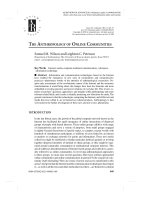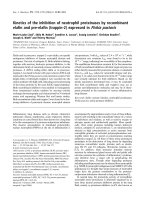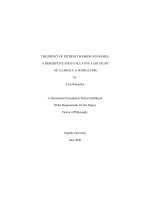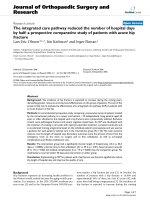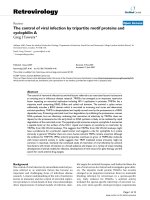The economics of sports 5th by michael a leed and allmen chapter 08
Bạn đang xem bản rút gọn của tài liệu. Xem và tải ngay bản đầy đủ của tài liệu tại đây (2.33 MB, 52 trang )
The Economics of Sports
FIFTH EDITION
Chapter 8
An Introduction to
Labor Markets in
Professional Sports
MICHAEL A. LEEDS | PETER VON ALLMEN
Incentives and Labor Supply
• Joe Louis and Oscar de la Hoya are two of the
greatest boxers ever
• Both fought longer than they should have
– Louis fought because he had so little money
– De la Hoya fought because he was offered so
much
• Both Louis’s and de la Hoya’s actions can be linked
to labor supply
Copyright ©2014 Pearson Education, Inc. All rights reserved.
8-2
Learning Objectives
• Understand the basic model of wage determination
in labor markets
• Be able to describe why the salaries of superstars
are much higher than the salaries of average
players
• Analyze the labor markets for individual sports,
such as golf and tennis
• Explain why players use performance-enhancing
drugs despite knowing their harmful effects
Copyright ©2014 Pearson Education, Inc. All rights reserved.
8-3
8.1 Labor Supply and Demand
• Figure 8.1 shows that in the last 20 years alone, the
average salary of a Major League Baseball player
has almost quadrupled
– From about $850,000 to over $3.3 million
• To put this in perspective, the average MLB salary
was approximately
– 36 times per capita GDP in 1991
– 65 times per capital GDP in 2011
• Salaries have risen similarly in other professional
sports, both in the US and abroad
Copyright ©2014 Pearson Education, Inc. All rights reserved.
8-4
Figure 8.1
Copyright ©2014 Pearson Education, Inc. All rights reserved.
8-5
Labor Supply
• The supply curve has a slightly different character
from the typical supply curve
• We usually see the price of a product on the vertical
axis and the quantity of a product on the horizontal
axis
• In labor markets, the price is the wage rate and the
quantity is the number of hours a worker chooses to
work
• The upward-sloping labor supply curve thus
indicates that a worker responds to higher wages by
offering more work time to employers
– See Figure 8.2a
Copyright ©2014 Pearson Education, Inc. All rights reserved.
8-6
Figure 8.2a
Copyright ©2014 Pearson Education, Inc. All rights reserved.
8-7
Sports Application
• One can analyze team sports markets in several
ways
• To analyze career length
• Players have no say over work hours
• The axes become salary per season and the number of
seasons
• To analyze the number of players hired in a season
• The axes become salary per season and the number of
players willing to work at a given salary
• See Figure 8.2b
Copyright ©2014 Pearson Education, Inc. All rights reserved.
8-8
Figure 8.2b
Copyright ©2014 Pearson Education, Inc. All rights reserved.
8-9
Boxing Application
– Fighters can choose how many fights they engage
in
• The axes become reward per fight and number
of fights
• The boxing example in Figure 8.2b shows that a boxer
is induced to take on more fights as his pay increases
– The player moves from point A to point B
– This was the case for Oscar de la Hoya
• The supply for Joe Louis shifted because his
savings/wealth was lower due to tax problems
– He moved from point A to point A’
Copyright ©2014 Pearson Education, Inc. All rights reserved.
8-10
Labor Supply Analysis
• The work decision is a trade-off between income and
leisure
– Wage is the opportunity cost of leisure
– As wages rise, leisure becomes more expensive
– The substitution effect is away from leisure: As wages
rise, workers work more
• But income rises with wages: with higher income,
workers can afford more of everything
– The income effect is positive for leisure and negative
for work: Workers buy more leisure & work less
• Typically, the substitution effect is stronger than the
income effect, so the supply curve slopes up
Copyright ©2014 Pearson Education, Inc. All rights reserved.
8-11
Labor Supply Curve
• De la Hoya made huge sums
– His substitution effect
exceeded his income
effect
– He fought more bouts
– His labor supply curve
slopes up
• Joe Louis made much less
– Why didn’t he fight less?
Prize money
S
Bouts
Copyright ©2014 Pearson Education, Inc. All rights reserved.
8-12
Moving the Labor Supply Curve
• Louis’s supply curve also
sloped up
• But he had financial trouble
– His income was
misappropriated He owed
back taxes
• His wealth was very low
– He could afford less of
everything, including
leisure
– Less leisure means more
labor
• His labor supply shifted right
Copyright ©2014 Pearson Education, Inc. All rights reserved.
Wage
S
S’
L; H
8-13
Labor Demand
• To analyze labor demand, we consider the following simple
scenario for firms
– They produce a single output using two inputs, capital (K)
– They operate in the short run (so capital is fixed)
– They can alter output (Q) only by changing the labor input
(L)
• We assume that all markets are perfectly competitive
– Firms cannot affect the market price of their output.
– Firms maximize profit by choosing L to maximize profit
• Profit is the difference between revenue and cost: profit
• It is maximized when marginal revenue (MR) from
employing one more worker equals the marginal cost of
employing that worker (MC)
Copyright ©2014 Pearson Education, Inc. All rights reserved.
8-14
Marginal Revenue Product
• Marginal benefit of a unit of labor is a new concept
– The extra worker produces extra output: Q/L =
MPL
– The output can be sold for additional revenue: MR
– Marginal Revenue Product (MRP)=MR*MPL
– In competitive markets, MR = P, the market price
– MRP = P x Q/L
• Marginal cost
– Wage or salary (w)
• The firm maximizes profits when w=MR*MPL
• The MRP is the firm’s demand for labor: Figure 8.3
Copyright ©2014 Pearson Education, Inc. All rights reserved.
8-15
Labor Demand Curve
• Labor demand slopes
down
– MPL falls as L rises
– So MRP also falls
• Measuring MRP can be
complicated
– What do players
produce?
– How do individual
statistics relate to the
team’s output?
– What is the market
value of that output?
Copyright ©2014 Pearson Education, Inc. All rights reserved.
8-16
One Way to Measure Labor
Demand in the NBA
• David Berri, Stacey Brook and Martin
Schmidt (2006) claim: MRPij =
MRwin*winsij
– MRPij = MRP of player i on team j
– MRwin = Revenue from 1 more win (~$1.67 M)
winsij = Added wins team j gets from player i
• They also claim
winsij = points + rebounds + steals + .5(blocks+
assists) – field goal attempts – turnovers – .5(free
throws + personal fouls)
Copyright ©2014 Pearson Education, Inc. All rights reserved.
8-17
Do Teams Reward Performance?
• Berri found that LeBron James produced 17.3 wins in
2011-12
– Most in the NBA (in a 62-game season)
– Made him worth $28.9 Million to the Miami Heat
– He was actually paid ~$17.5 Million
• The third most valuable player was Tyson Chandler
– He scored only 11.3 points per game
– But he produced 13.3 wins – worth ~$22.2 million
– He was paid “only” $13.6 million
• Berri asserts that teams reward points more than
performance
Copyright ©2014 Pearson Education, Inc. All rights reserved.
8-18
Imperfect Competition
• If we assume imperfection in the product market, then
MR no longer equals the market price
• Recall that to sell another unit of output, the
monopolist must sell all previous units at a lower
price, so his MR curve is always below his demand
curve
– This is illustrated in Figure 8.4
• A monopolist hires fewer workers and pays lower
wages than it would if the industry were competitive
• This is consistent with the fact that monopolists
restrict output as part of their strategy to maximize
profits
Copyright ©2014 Pearson Education, Inc. All rights reserved.
8-19
Figure 8.3
Copyright ©2014 Pearson Education, Inc. All rights reserved.
8-20
Figure 8.4
Copyright ©2014 Pearson Education, Inc. All rights reserved.
8-21
Labor Market Equilibrium
• The market demand curve is the
summation of all individual demand
curves
– This is a summation over all teams in a league
• The market supply curves is the
summation of all individual supply curves
– This is a sum across all players
• See Figure 8.5
Copyright ©2014 Pearson Education, Inc. All rights reserved.
8-22
Figure 8.5
Copyright ©2014 Pearson Education, Inc. All rights reserved.
8-23
Impact of Growing Popularity
• Equilibrium is where demand
and supply meet
• As the NBA became more
popular in the 1970s
– The value of players’
output rose
– MR rose as ticket prices
did
– Marginal product was
unchanged
– Demand shifted right
– Salaries rose and rosters
increased
Copyright ©2014 Pearson Education, Inc. All rights reserved.
w
D’
S
e’
D
e
L
8-24
The 2008 Recession
• The recession
reduced revenues
– Fans could not afford
tickets
– Sponsors cut back on
marketing
• This reduced the
value of output
w
D”
D’
S
D
e”
e’
e
– Demand shifted left
– Salaries fell
L
Copyright ©2014 Pearson Education, Inc. All rights reserved.
8-25
